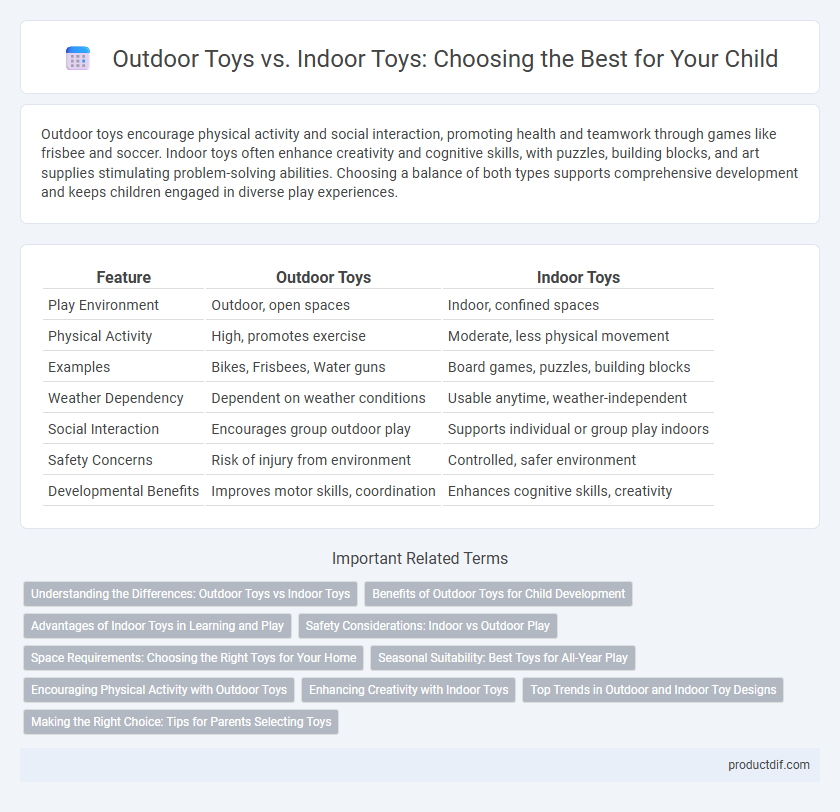Outdoor toys encourage physical activity and social interaction, promoting health and teamwork through games like frisbee and soccer. Indoor toys often enhance creativity and cognitive skills, with puzzles, building blocks, and art supplies stimulating problem-solving abilities. Choosing a balance of both types supports comprehensive development and keeps children engaged in diverse play experiences.
Table of Comparison
| Feature | Outdoor Toys | Indoor Toys |
|---|---|---|
| Play Environment | Outdoor, open spaces | Indoor, confined spaces |
| Physical Activity | High, promotes exercise | Moderate, less physical movement |
| Examples | Bikes, Frisbees, Water guns | Board games, puzzles, building blocks |
| Weather Dependency | Dependent on weather conditions | Usable anytime, weather-independent |
| Social Interaction | Encourages group outdoor play | Supports individual or group play indoors |
| Safety Concerns | Risk of injury from environment | Controlled, safer environment |
| Developmental Benefits | Improves motor skills, coordination | Enhances cognitive skills, creativity |
Understanding the Differences: Outdoor Toys vs Indoor Toys
Outdoor toys, designed to withstand weather elements and encourage physical activity, include items such as bikes, swings, and water guns, promoting gross motor skills and social interaction. Indoor toys, like puzzles, board games, and building blocks, are crafted for controlled environments, emphasizing cognitive development and fine motor skills. Recognizing these differences helps parents select appropriate toys that enhance children's growth based on play setting and developmental goals.
Benefits of Outdoor Toys for Child Development
Outdoor toys promote physical health by encouraging active play, improving motor skills, coordination, and overall fitness in children. Exposure to natural light and fresh air through outdoor play enhances cognitive development and emotional well-being, reducing stress and boosting mood. Social interactions during outdoor play strengthen communication skills, teamwork, and problem-solving abilities, fostering essential social development.
Advantages of Indoor Toys in Learning and Play
Indoor toys enhance cognitive development by providing controlled environments that encourage focused learning and creativity. They offer year-round access regardless of weather, supporting consistent skill-building in areas like problem-solving and fine motor coordination. Many indoor toys also facilitate social interaction and communication skills through cooperative play within a safe space.
Safety Considerations: Indoor vs Outdoor Play
Outdoor toys require robust safety features like weather-resistant materials and non-toxic finishes to withstand elements and prevent injuries during active play. Indoor toys emphasize soft edges, non-slip bases, and low-toxicity materials to ensure safe use in confined spaces and minimize accidents. Supervision and age-appropriate design remain crucial for both environments to optimize safety during playtime.
Space Requirements: Choosing the Right Toys for Your Home
Outdoor toys often require ample space such as backyards or parks to ensure safe and enjoyable play, making them ideal for families with larger outdoor areas. Indoor toys are designed for compact spaces, offering versatile options that fit comfortably within living rooms, bedrooms, or playrooms without cluttering the environment. Evaluating the available space in your home is essential to selecting the right toys, balancing safety, fun, and convenience.
Seasonal Suitability: Best Toys for All-Year Play
Outdoor toys such as water guns, frisbees, and bubble makers thrive in warm weather, making them ideal for spring and summer play. Indoor toys like puzzles, building blocks, and board games provide entertainment during cold or rainy seasons, ensuring continuous engagement regardless of outdoor conditions. Selecting toys that match seasonal suitability enhances year-round play experiences and supports children's development through varied physical and cognitive activities.
Encouraging Physical Activity with Outdoor Toys
Outdoor toys such as trampolines, bikes, and ball games significantly boost children's physical activity levels by promoting movement and coordination in open spaces. These toys improve cardiovascular health, muscle strength, and motor skills more effectively than indoor toys, which often encourage sedentary behavior. Engaging with outdoor toys also supports mental well-being and social interaction through active play in natural environments.
Enhancing Creativity with Indoor Toys
Indoor toys such as building blocks, art kits, and puzzles play a crucial role in enhancing creativity by encouraging problem-solving and imaginative play within a controlled environment. These toys stimulate cognitive development and fine motor skills, providing a platform for children to experiment with colors, shapes, and patterns without the distractions of outdoor elements. Unlike many outdoor toys that emphasize physical activity, indoor toys offer diverse opportunities for intellectual growth and creative expression.
Top Trends in Outdoor and Indoor Toy Designs
Outdoor toys are increasingly designed with durable, eco-friendly materials that promote physical activity, such as balance bikes and climbing structures. Indoor toys emphasize STEM learning and interactive technology, featuring coding kits, augmented reality puzzles, and sensory playsets. Popular trends include modular designs that encourage creativity and adaptability for various age groups, blending entertainment with educational value.
Making the Right Choice: Tips for Parents Selecting Toys
When selecting toys, parents should consider the developmental benefits of outdoor toys like balance bikes and climbing sets, which promote physical activity and motor skills. Indoor toys such as puzzles and building blocks enhance cognitive abilities and creativity, offering a quiet play environment. Balancing both types ensures a well-rounded play experience supporting physical, social, and intellectual growth.
Outdoor toys vs indoor toys Infographic

 productdif.com
productdif.com